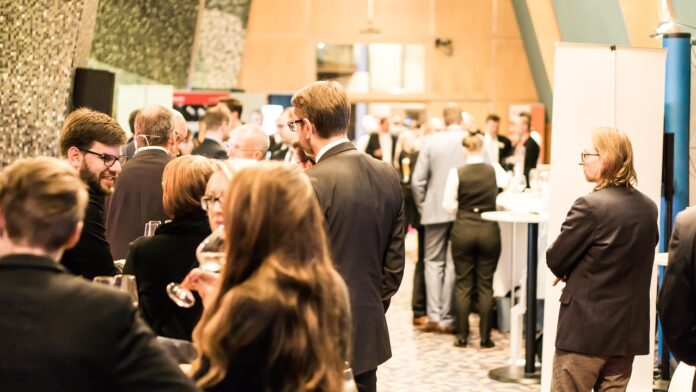Hybrid Is Here to Stay
Hybrid events are no longer a temporary fix. What began as an emergency response has evolved into a lasting format that combines the immediacy of in-person experiences with the reach and flexibility of digital.
At first, the hybrid surge was driven by circumstance. But what’s kept it going is something more powerful accessibility, convenience, and data-driven insights that traditional setups often can’t deliver.
Now that hybrid events are becoming the standard, a more complex question is emerging. Are we truly designing with both types of attendees in mind, or are we unconsciously prioritising one over the other?
This goes beyond tech choices. It’s a strategic shift. And how we respond could shape the future of the entire events industry. The Chameleon Agency event designer in Manchester put this guide together to help event professionals face that challenge head-on.
One Event, Two Very Different Experiences
Let’s be honest. Hybrid events naturally divide your audience.
You’ve got attendees in the room, feeding off the energy of the space, building connections through spontaneous chats, and expecting tactile, in-the-moment experiences.
Then there are the virtual participants, tuning in from home or on the move. They want something polished, engaging, and interactive—without feeling like second-class spectators.
These are not just different preferences. They’re fundamentally different modes of engagement. And more often than not, we see organisers delivering a fantastic in-person experience while the online side feels like a passive afterthought.
That’s where the concept of experience equity becomes essential. Every attendee should feel they’ve had meaningful value. But creating that sense of fairness is anything but straightforward.
What UX Designers Have Known All Along
This challenge isn’t unique to events. UX professionals have been working through similar issues for years, crafting seamless experiences across phones, tablets, laptops, and beyond.
Their guiding principle is simple. One experience, delivered through multiple formats.
That mindset applies beautifully to hybrid events. Rather than building two separate programmes, the aim should be to create one unified experience that adapts to each audience. This is what adaptive event design is all about. The delivery might vary, but the emotional and cognitive journey should remain intact.
Start With the Split, Then Find the Thread
Successful hybrid events don’t pretend everyone is having the same experience. They start by respecting the differences and then design deliberately to connect the two sides.
First, serve each group on their own terms
On-site guests want the energy of real-world interactions. Give them the chance to network face to face, explore physical environments, and take part in impromptu moments. Meanwhile, your virtual attendees deserve more than a passive stream. Think exclusive online-only content, backstage access, and intuitive tools that let them participate on their terms.
Then, create shared moments
Encourage live polling across both audiences. Broadcast keynotes simultaneously. Set up breakout rooms or panel discussions where people can interact regardless of how they’re attending.
Cisco Live 2023 got this right. Their dedicated digital track wasn’t just a replay of the main stage it was thoughtfully curated for online viewers. The result? A 30 percent increase in remote engagement.
The Tools Are Ready. The Thinking Needs to Catch Up
It’s easy to blame lacklustre hybrid experiences on the technology. But the real issue isn’t the platforms it’s the mindset behind the planning.
Today’s event tools like Hopin, Cvent, Bizzabo and vFairs are more than capable. They offer interactive features, live chat, breakout capabilities, gamified experiences, and rich data tracking.
What’s often missing is the willingness to design with both audiences in mind from the outset. Too many events are still structured like it’s 2019, simply bolting digital elements onto a live plan.
Measuring What Actually Matters
If you want to know whether your hybrid event succeeded, it’s time to look past headcounts and smiley-face surveys.
Start tracking things like:
Virtual engagement duration
Are remote viewers sticking around past the opening keynote?
Cross-audience interaction
Are people contributing across platforms, or is one group just watching from the sidelines?
Content performance by format
Which sessions shine online, and which only land well in person?
Inclusivity of participation
Can everyone ask questions, join conversations, and influence the shape of the event?
Platforms such as SpotMe and Brella make it easier to gather these insights in real time, so you can fine-tune your approach on the fly.
Hybrid Done Right Is Inclusive, Scalable and Greener
When it’s thoughtfully executed, hybrid isn’t just a compromise it’s a leap forward.
Think of the benefits. No flights to book. No hotels to fill. No visa applications to stress over. Someone in Edinburgh can now engage just as easily as someone in Brussels. That’s not just convenient. It’s fairer, more cost-effective and significantly more sustainable.
According to a 2023 report from the Virtual Events Institute, shifting to virtual-first formats can reduce emissions by up to 80 percent per attendee.
There’s also a major win in terms of accessibility. Captioning, language translation and screen reader compatibility are easier to implement online, giving more people the chance to fully participate.
It’s Not About Two Events. It’s One Experience With Two Perspectives.
The future of hybrid isn’t about choosing between audiences. It’s about designing with clarity.
You’re not hosting two events. You’re crafting one cohesive experience, delivered in two different ways. That’s not a compromise it’s a mindset shift. And it places the focus exactly where it belongs on your audience, not your venue.
The events that embrace this shift won’t just broaden their reach. They’ll deepen their impact online, in person, and everywhere in between.







